National Treasure Hall
The Eight Kinds of Mythological Beings (National Treasures)
Ashura
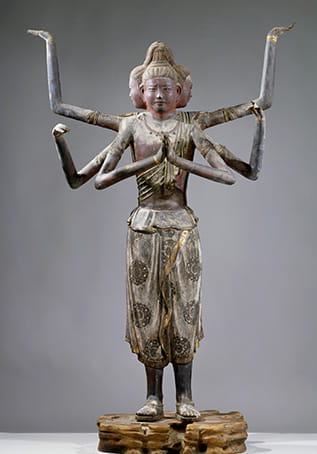
Dated to 734, this magnificent sculpture is known around the world as one of the greatest masterpieces of Japanese Buddhist art. It depicts an Ashura — a demigod of Indian mythology usually associated with negative emotions such as greed, hatred, and wrath. Once incorporated into the Buddhist pantheon, the Ashura became protectors of the Buddha and his teachings. In this role, Ashura are usually depicted as armored, muscular beings with bright red, scowling faces, tusk-like fangs, and hair that stands on end to symbolize their rage. One of the reasons for the fame of the Kohfukuji Ashura, therefore, is that it does not look the way it ought to.
The slender figure is clothed in a flowing, realistic-looking sash and trouser-like skirt, and wears wooden sandals on its feet. Of its three pairs of hands, the uppermost pair would have held red and white disks symbolizing the sun and moon, and the middle ones a bow and arrow. The foremost hands, meanwhile, are joined together in a gesture of worship, perhaps to express an act of repentance triggered by hearing the teachings of the Buddha. The idea of repentance might also explain the strange expressions on the statue’s three faces: the central face conveys an aura of quiet dejection and contrition, while the faces on either side betray a sense of resentment or annoyance, with the one on the statue’s right going so far as to bite its own lower lip.
Like all of the sculptures of the Eight Kinds of Mythological Beings, the Ashura image is made of layers of lacquer-impregnated cloth over a hollow core. Computed tomography (CT) scans have shown that beneath the front face lies a second face with deeply knitted brows, a strong jaw, and an open mouth. In response, some scholars have suggested that the patroness of the statue, Empress Kōmyō (701–760), had the original face covered up and re-modelled with a gentler, more youthful one in memory of her son, Crown Prince Motoi, who died in 728 shortly before his first birthday.
Gobujō
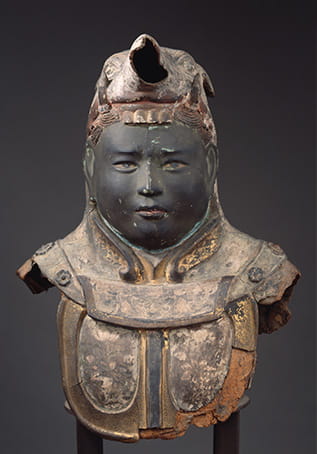
Dated to 734, this bust stems from an image of Gobujō that formed part of the set of sculptures collectively known as the Eight Kinds of Mythological Beings. The image portrays Gobujō as a young boy who gazes off into the distance with a proud facial expression while wearing armor and an elephant skin wrapped around his shoulders with the elephant’s head covering his own like a helmet. These features suggest that the image now identified as Gobujō might originally have been meant to portray a deva, a class of deities incorporated into Buddhism from Indian mythology.
Like the other sculptures in the set, the image of Gobujō was made using the hollow-core dry-lacquer technique. It is the only one of the eight to have suffered substantial damage. Aside from bust remaining at Kohfukuji, the only parts to survive are the right hand and forearm, which were donated to the Tokyo National Museum in the Meiji Period (1868–1912).
Sakara
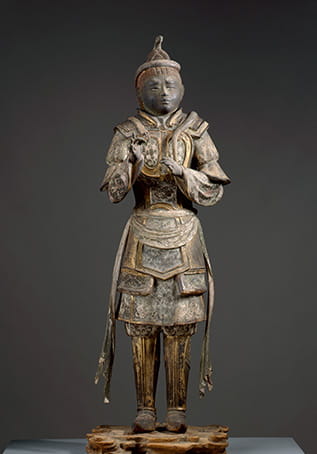
This statue depicts Sakara, a mythological being derived from Nāgarāja, the Indian king of the snakes. Sakara is portrayed as a youthful warrior in armor with a snake draped over his shoulder and coiled up around his topknot. As the snake deity legend traveled from India to China, the snake was identified the dragon, an important figure in Chinese mythology frequently associated, in the figure of the Dragon King, with water and rain. This Sinicized dragon cult was then introduced to Japan, where dragons continue to be venerated as water deities associated with rainfall and bountiful harvests to this day.
Like all the statues of Eight Kinds of Mythological Beings, this work was produced between 733 and 734, and was made using the hollow-core dry-lacquer technique.
Karura
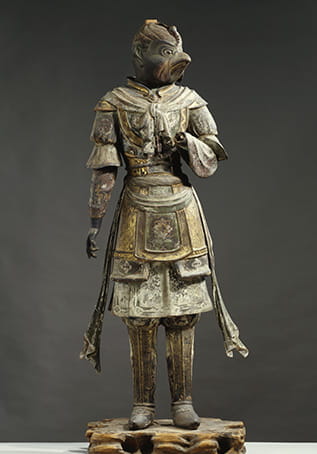
This statue depicts Karura, a birdlike creature derived from the mythical bird of Indian folklore, Garuda. Karura is portrayed as an armored warrior with a prominent beak and avian eyes but human ears and hair. Like Garuda, Karura is the enemy of the nāgas (snakes or dragons), making this statue is a companion piece to the one of Sakara.
Although the fine details on the armor and robes have survived the ravages of time, the statue is missing both its left hand and the coxcomb that would have risen above its head.
Like all the statues of Eight Kinds of Mythological Beings, this work is dated to 734 and was made using the hollow-core dry-lacquer technique.
Kubanda
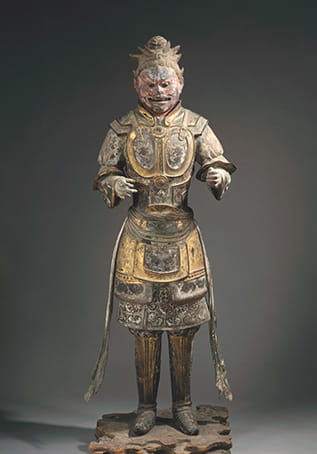
This is a statue of Kubanda, one of the Eight Kinds of Mythological Beings. Although the exact identity of Kubanda is uncertain, he is thought to be a yakṣa, a class of beings that appear in Indian folklore both as benign nature spirits and as malevolent ghosts that prey on hapless travelers. With its glaring eyes and bared teeth, the Kohfukuji Kubanda appears closer to the latter.
In Buddhism, yakṣa (Jp. yasha) are portrayed as the attendants of Bishamonten (also known as Tamonten), a deity of war and one of the Four Heavenly Kings. Also known as the guardian of the north, Bishamonten is regarded as a benign deity who protects the Buddhist practitioners from physical and spiritual harm.
Like all the statues of Eight Kinds of Mythological Beings, this work is dated to 734 and was made using the hollow-core dry-lacquer technique.
Kendatsuba
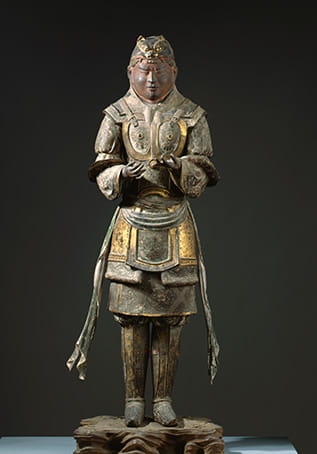
This statue depicts a Kendatsuba, a mythical musician that originally served at the heavenly court of the Indian god Indra. When Indra was incorporated into the Buddhist pantheon as Taishakuten, the ruler of one of the heavens of Buddhist cosmology, his various attendants -the Kendatsuba among them- continued to fulfill their original functions in a newly Buddhist setting. Aside from their role as servants to Taishakuten, these musicians are also portrayed as attendants to Jikokuten, one of the Four Heavenly Kings, in addition to being deities of medicine, and guardians of children and the Buddhist teachings.
The image at Kohfukuji portrays the Kendatsuba with its eyes squeezed tightly shut. On top of a full suit of armor, it wears the skin of a lion wrapped around his shoulders, with the lion’s head covering its own like a helmet.
Like all the statues of Eight Kinds of Mythological Beings, this work is dated to 734 and was made using the hollow-core dry-lacquer technique.
Kinnara
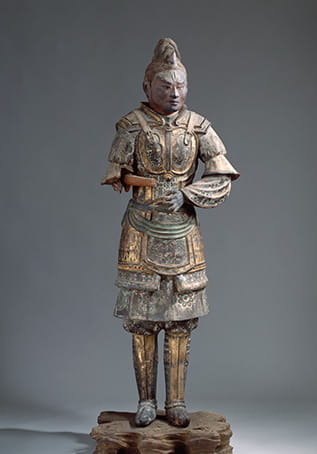
This image depicts a Kinnara, a class of beings in Indian mythology (where they are called Kiṃnara) who serve as celestial musicians. In Japanese Buddhist belief, kinnara serve as attendants in the courts of Bishamonten (also known as Tamonten), a deity of war and one of the Four Heavenly Kings, and Taishakuten, the ruler of one of the heavens of Buddhist cosmology.
Like all the statues of Eight Kinds of Mythological Beings, this work is dated to 734 and was made using the hollow-core dry-lacquer technique.
Hibakara
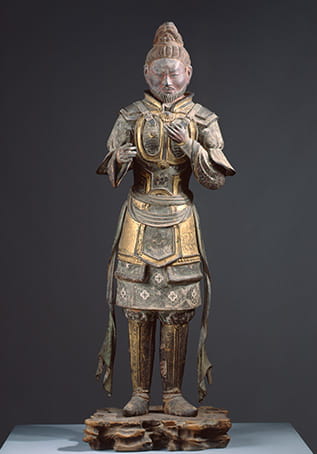
Traditionally identified as Hibakara, this image stands out among the Eight Kinds of Mythological Beings for several reasons.
First, the name Hibakara is unique to this particular statue, and not attested anywhere else in Japanese Buddhism. It is thought that the image was originally intended to portray a magoraga, a class of beings derived from Indian mythology (where they are referred to as mahoraga) that are variously described as snakes, or as musicians with snakelike attributes.
Second, while the Hibakara wears the same style of armor as most of the other figures in the Eight Kinds of Mythological Beings, it does not have a boyish face, but is instead depicted as a middle-aged man with a luscious full beard.
Like all the statues of Eight Kinds of Mythological Beings, this work is dated to 734 and was made using the hollow-core dry-lacquer technique.

